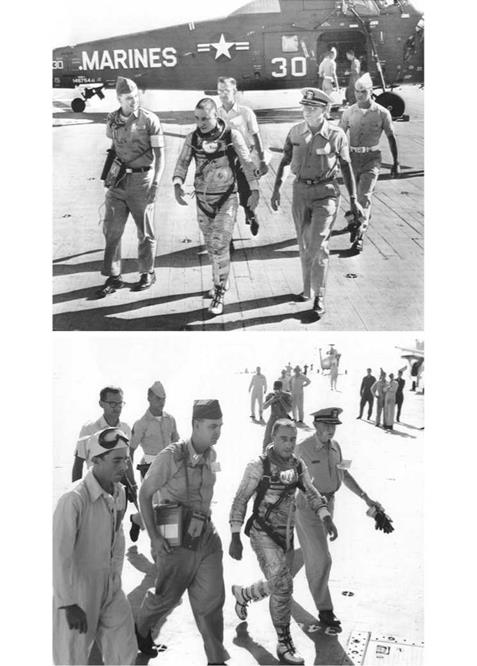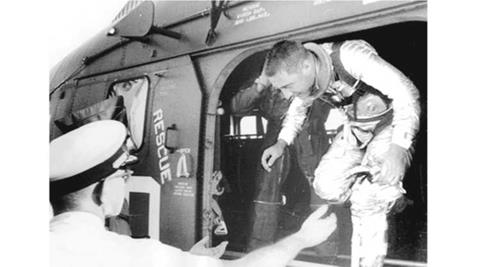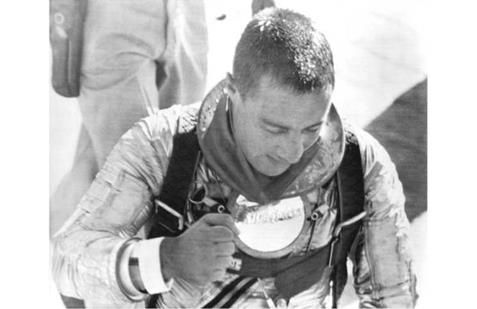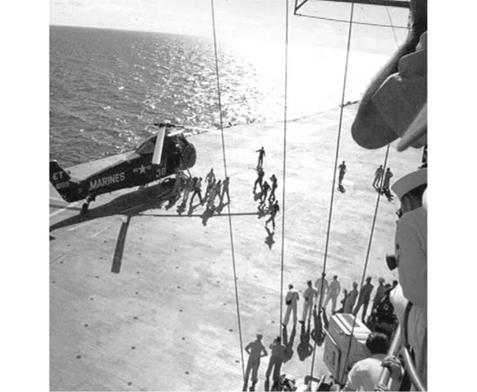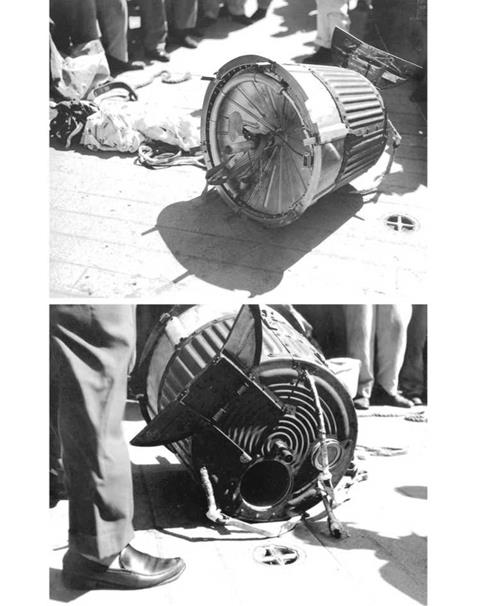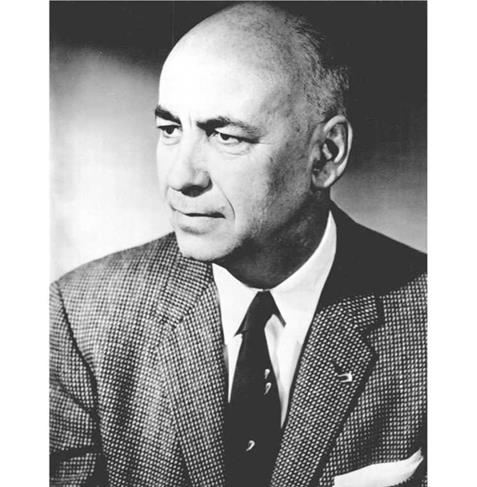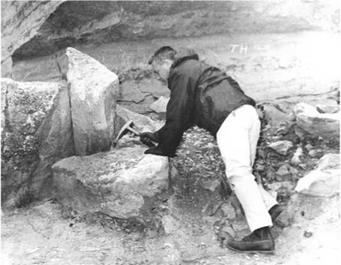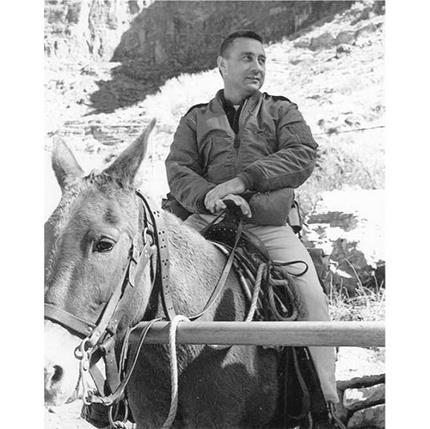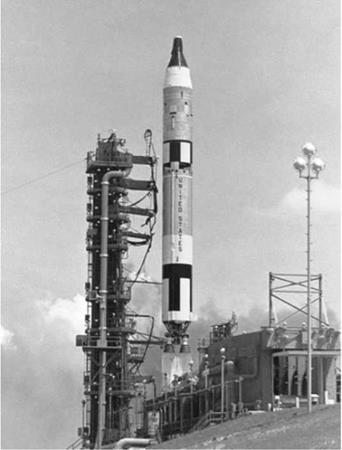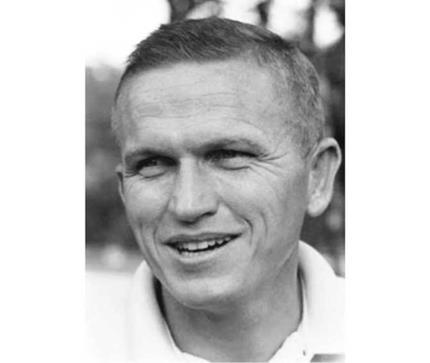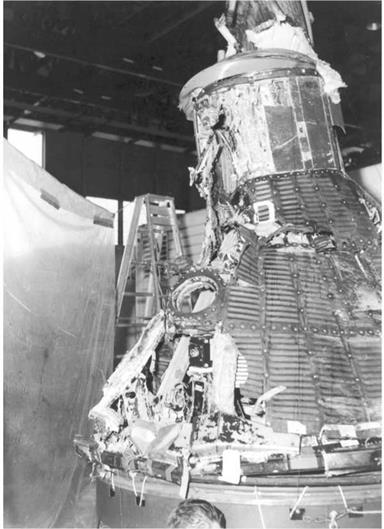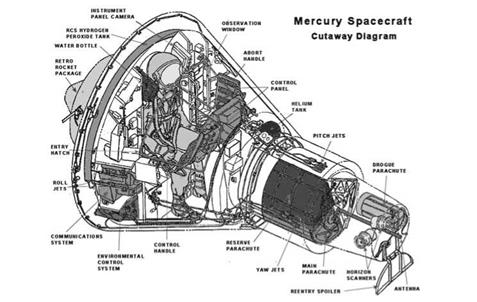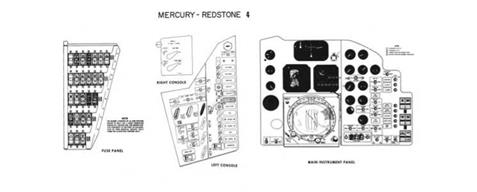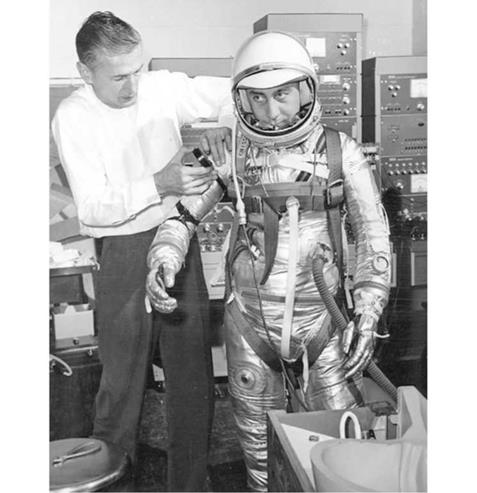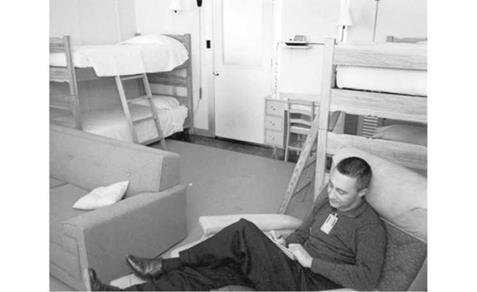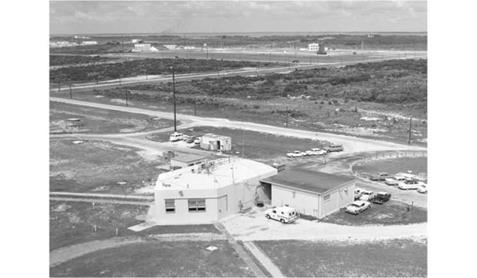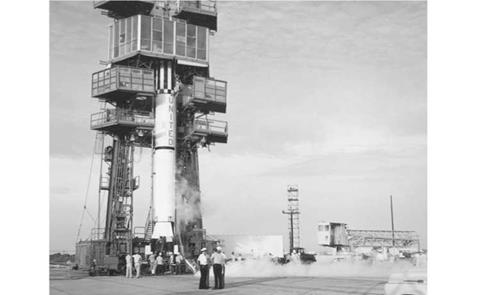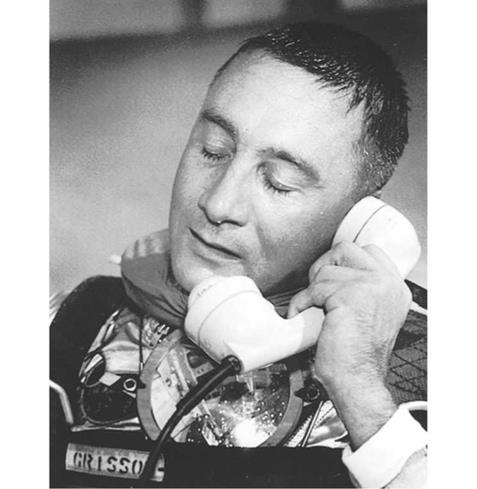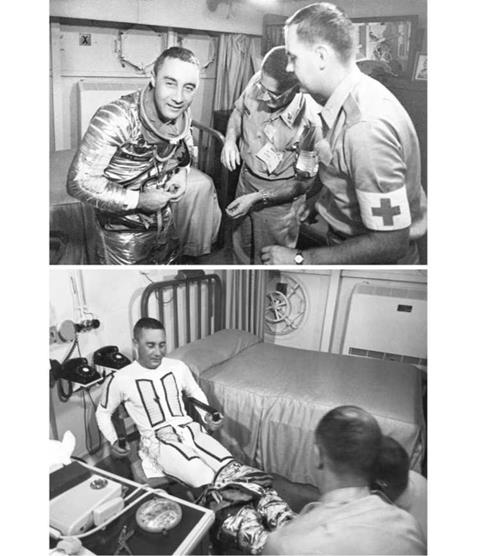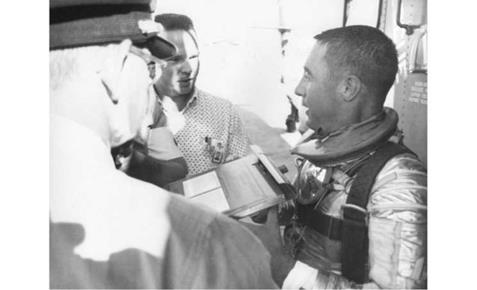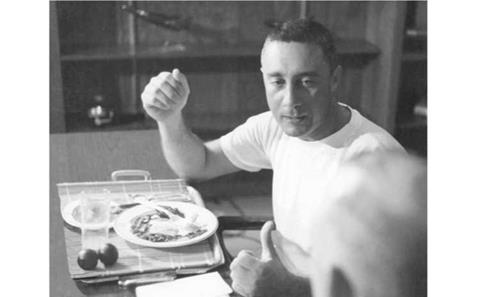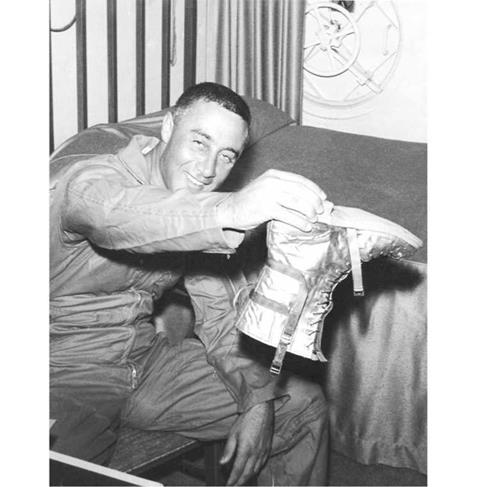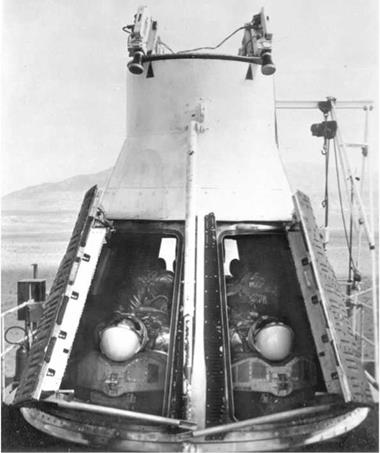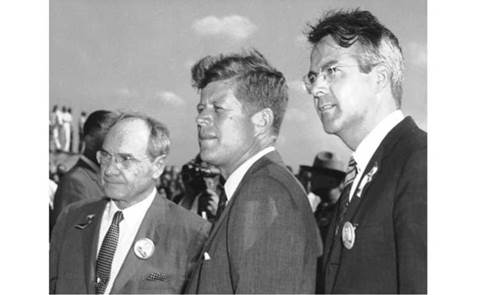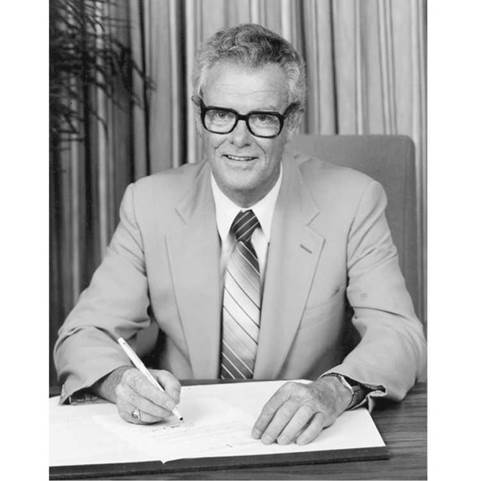On the day of the flight I followed the following schedule:
Event a. m. e. s.t.
Awakened………………………………………………………. 1.10
Breakfast……………………………………………………….. 1:25
Physical examination……………………………………….. 1:55
Sensors attached……………………………………………… 2:25
Suited up……………………………………………………….. 2:35
Suit pressure check………………………………………….. 3:05
Entered transfer van………………………………………… 3:30
Arrived atpad………………………………………………….. 3:55
Manned the spacecraft……………………………………… 3:58
Launched……………………………………………………….. 7:20
As can be seen, 6 hours and 10 minutes elapsed from the time I was awakened until launch. This time is approximately evenly divided between activities prior to my reaching the pad and time I spent at the pad. In this case, we were planning on a launch at 6:00 a. m., e. s.t., but it will probably always be normal to expect some holds that cannot be predicted. While this time element appears to be excessive, we can find no way to reduce it below this minimum at the present. Efforts are still continuing to reduce the pre-countdown time so that the pilot will not have had an almost full working day prior to liftoff.
After insertion in the spacecraft, the launch countdown proceeded smoothly and on schedule until T-45 minutes when a hold was called to install a misaligned bolt in the egress hatch.
After a hold of 30 minutes, the countdown was resumed and proceeded to T-30 minutes when a brief hold was called to turn off the pad searchlights. By this time, it was daylight; and the lights, which cause interference with launch-vehicle telemetry, were no longer needed.
One more hold was called at T-15 minutes to await better cloud conditions because the long focal length cameras would not have been able to obtain proper coverage through the existing overcast.
After holding for 41 minutes, the count was resumed and proceeded smoothly to liftoff at 7:20 a. m., e. s.t.
The communications and flow of information prior to liftoff were very good. After participating in the pre-launch test and the cancellation two days previously, I was very familiar with the countdown and knew exactly what was going on at all times.
As the Blockhouse Capsule Communicator (Cap Com) called ignition, I felt the launch vehicle start to vibrate and could hear the engines start. Just seconds after this the time – elapsed clock started and the Mercury Control Center Cap Com confirmed liftoff. At that time I punched the Time Zero Override, started the stopwatch function on the spacecraft clock, and reported that the elapsed-time clock had started.
The powered flight portion of the mission was in general very smooth. A low-order vibration started at approximately T+50 seconds, but it did not develop above a low level and was undetectable after about T+70 seconds. This vibration was in no way disturbing and it did not cause interference in either communications or vision. The magnitude of the accelerations corresponds well to the launch simulations on the centrifuge, but the onset was much smoother.
Communications throughout the powered flight were satisfactory. The VOX (voice operated relay) was used for pilot transmissions instead of the push-to-talk button. The noise level was never high enough at any time to key the transmitter. Each standard report was made on time and there was never any requirement for myself or the Cap Com to repeat any transmission.
Vision out the window was good at all times during launch. As viewed from the pad, the sky was its normal light blue; but as the altitude increased, the sky became a darker and darker blue until approximately two minutes after liftoff, which corresponds to an altitude of approximately 100,000 feet, the sky rapidly changed to an absolute black. At this time, I saw what appeared to be one rather faint star in the center of the window. It was about equal in brightness to Polaris. Later, it was determined that this was the planet Venus whose brightness is equal to a star of magnitude of minus three.
Launch-vehicle engine cutoff was sudden and I could not sense any tail-off of the launch vehicle. I did feel, as I described earlier, a very brief tumbling sensation. The firing of the escape-tower clamp ring and escape rocket is quite audible and I could see the escape rocket motor and tower throughout its tail-off burning phase and for what seemed like quite some time after that climbing off to my right. Actually, I think I was still watching the tower at the time the posigrade rockets fired, which occurred ten seconds after cutoff. The tower was still definable as a long, slender object against the black sky at this time.
The posigrade firing is a very audible bang and a definite kick, producing a deceleration of approximately 1g. Prior to this time, the spacecraft was quite stable, with no apparent motion. As the posigrade rockets separated the spacecraft from the launch vehicle, the spacecraft angular motions and angular accelerations were quite apparent. Spacecraft damping which was to begin immediately after separation was apparently satisfactory, although I cannot really report on the magnitude of any angular rates caused by posigrade firing.
The spacecraft turnaround to retro-fire attitude is quite a weird maneuver to ride through. At first, I thought the spacecraft might be tumbling out of control. A quick check of the instruments indicated that turnaround was proceeding much as those experienced on the procedures trainer, with the exception of roll attitude which appeared to be very slow and behind the schedule that I was expecting.
As the turnaround started, I could see a bright shaft of light, similar to the sun shining into a blackened room, start to move from my lower left up across my torso. Even though I knew the window reduces light transmissions equivalent to the Earth’s atmosphere, I was concerned that it might shine directly into my eyes and blind me. The light moved across my torso and disappeared completely.
A quick look through the periscope after it extended did not provide me with any useful information. I was unable to see land, only clouds and the ocean.
The view through the window became quite spectacular as the horizon came into view. The sight was truly breathtaking. The Earth was very bright, the sky was black, and the curvature of the Earth was quite prominent. Beneath the Earth and sky, there was a border which started at the Earth as a light blue and became increasingly darker with altitude. There was a transition region between the dark blue and the black sky that is best described as a fuzzy grey area. This is a very narrow band, but there is no sharp transition from blue to black. The whole border appeared to be uniform in height over the approximately 1,000 miles of horizon that was visible to me.
The Earth itself was very bright. The only landmark I was able to identify during the first portion of the weightlessness period was the Gulf of Mexico coastline between Apalachicola, Florida, and Mobile, Alabama. The cloud coverage was quite extensive and the curvature of this portion of the coast was very difficult to distinguish. The water and land masses were both a hazy blue, with the land being somewhat darker. There was a frontal system south of this area that was clearly defined.
One other section of the Florida coast came into view during the left yaw maneuver, but it was a small section of beach with no identifiable landmarks.
The spacecraft automatic stabilization and control system (ASCS) had made the turnaround maneuver from the position on the launch vehicle to retro-fire attitude. The pitch and yaw axes stabilized with only a moderate amount of overshoot as predicted, but the roll attitude was still being programmed and was off by approximately 15° when I switched from the autopilot to the manual proportional control system. The switchover occurred ten minutes later than planned to give the ASCS more time to stabilize the spacecraft. At this point, I realized I would have to hurry my programmed pitch, yaw and roll maneuvers. I tried to hurry the pitch-up maneuver; I controlled the roll attitude back within limits, but the view out the window had distracted me, resulting in an overshoot in pitch. This put me behind in my schedule even more. I hit the planned yaw rate but overshot in yaw attitude again. I realized that my time for control maneuvers was up and I decided at this point to skip the planned roll maneuver, since the roll axis had been exercised during the two previous maneuvers, and go immediately to the next task.
This was the part of the flight to which I had been looking forward. There was a full minute that was programmed for observing the Earth. My observations during this period have already been reported in this paper, but the control task was quite easy when only the horizon was used as a reference. The task was somewhat complicated during this phase, as a result of lack of yaw reference. This lack was not a problem after retrofire when Cape Canaveral came into view. I do not believe yaw attitude will be a problem in orbital flight because there should be ample time to pick adequate checkpoints; even breaks in cloud formations would be sufficient.
The retro-sequence started automatically and at the time it started, I was slightly behind schedule. At this point, I was working quite hard to get into a good retro-fire attitude so that I could fire the retro-rockets manually. I received the countdown to fire from Mercury Control Center Cap Com and fired the retro-rockets manually. The retro-rockets, like the escape rockets and posigrades, could be heard quite clearly. The thrust buildup was rapid and smooth. As the first retro-rocket fired, I was looking out the window and I could see that a definite yaw to the right was starting. I had planned to control the spacecraft attitude during retro-fire by using the horizon as a reference, but as soon as the right yaw started, I switched my reference to the flight instruments. I had been using my instruments during my retro-fire practice for the two weeks prior to the launch in the Cape Canaveral procedures training since the activity at the Cape prevented the use of the ALFA trainer located at the NASA-Langley Air Force Base. This probably explains the instinctive switch to the flight instruments.
The retro-fire difficulty was about equal to the more severe cases that have been presented on the procedures trainer.
Immediately after retro-fire, Cape Canaveral came into view. It was quite easy to identify. The Banana and Indian Rivers were easy to distinguish and the white beach all along the coast was quite prominent. The colors that were the most prominent were the blue of the ocean, the brownish-green of the interior, and the white in between, which was obviously the beach and surf. I could see the building area on Cape Canaveral. I do not recall being able to distinguish individual buildings, but it was obvious that it was an area where buildings and structures had been erected.
Immediately after retro-fire, the retro-jettison switch was placed in the armed position, and the control mode was switched to the rate command control system. I made a rapid check to ascertain that the system was working in all axes and then I switched from the UHF transmitter to the HF transmitter.
This one attempt to communicate on HF was unsuccessful. At approximately peak altitude, the HF transmitter was turned on and the UHF transmitter was turned off. All three receivers – UHF, HF, and emergency voice – were on continuously. Immediately after I reported switching to HF, the Mercury Control Center started transmitting to me on HF only. I did not receive any transmission during this period. After allowing the HF transmitter approximately ten seconds to warm up, I transmitted but received no acknowledgement that I was being received. Actually, the Atlantic Ship telemetry vessel located in the landing area and the Grand Bahama Island did receive my HF transmissions. Prior to the flight, both stations had been instructed not to transmit on the assigned frequencies unless they were called by the pilot. After switching back to the UHF transmitter, I received a call on the emergency voice that was loud and clear. UHF transmissions were satisfactory throughout the flight. I was in continuous contact with some facility at all times, with the exception of a brief period on HF.
Even though all communications equipment operated properly, I felt that I was hurrying all transmissions too much. All of the sights, sounds, and events were of such importance that I felt compelled to talk of everything at once. It was a difficult choice to decide what was the most important to report at any one time. I wanted as much as possible recorded so that I would not have to rely on my memory so much for later reporting.
As previously mentioned, the control mode was switched from manual proportional to rate command immediately after retro-fire. The procedures trainer simulation in this system seems to be slightly more difficult than the actual case. I found attitudes were easy to maintain and rates were no problem. The rate command system was much easier to fly than the manual proportional system. The reverse is normally true on the trainer. The sluggish roll system was probably complicating the control task during the manual proportional control phase of the flight, while roll accelerations appeared to be normal on the rate command system.
The rate command control system was used after retro-fire and throughout the reentry phase of the flight. At the zero rate command position, the stick was centered. This system had a deadband of plus or minus 3 degrees per second. Our experience on the procedures trainer had indicated that this system was more difficult to fly than the manual proportional control system. This was not the case during this flight. Zero rates and flight attitudes were easy to maintain. The records do indicate that an excessive amount of fuel was expended during this period. Approximately 15 percent of the manual fuel supply was used during the two minutes the system was operating. A major portion of the two-minute period was during the reentry when thrusters were operating almost continuously to dampen the reentry oscillations.
The 0.5 g telelight illuminated on schedule and shortly thereafter I reported g’s starting to build. I checked the accelerometer and the g level was something less than 1 g at this time. The next time I reported, I was at 6 g and I continued to report and function throughout the high-g portion of the flight.
The spacecraft rates increased during the reentry, indicating that the spacecraft was oscillating in both yaw and pitch. I made a few control inputs at this time, but I could not see any effects on the rates, so I decided just to ride out the oscillations. The pitch rate needle was oscillating full scale at a rapid rate of plus or minus 6 degrees per second during this time and the yaw rate began oscillating full scale slightly later than pitch. At no time were these oscillations noticeable inside the spacecraft.
During this phase of reentry, and until main parachute deployment, there is a noticeable roar and a mild buffeting of the spacecraft. This is probably the noise of a blunt object moving rapidly through the atmosphere and the buffeting is not distracting nor does it interfere with pilot function.
The drogue parachute deployment is quite visible from inside the spacecraft and the firing of the drogue chute mortar is clearly audible. The opening shock of the drogue parachute is mild; there is a mild pulsation or breathing of the drogue parachute which can be felt inside the spacecraft.
As the drogue parachute is released, the spacecraft starts to drop at a greater rate. The change in g-field is quite noticeable. Main parachute deployment is visible out the window also. A mild shock is felt as the main parachute deploys in its reefed condition. The complete parachute is visible at this time. As the reefing cutters fire, the parachute deploys to its fully opened condition. Again, a mild shock is felt. About 80 percent of the parachute is visible at this time and it is quite a comforting sight. The spacecraft rotates and swings slowly under the parachute at first; the rates are mild and hardly noticeable.
The spacecraft landing in the water was a mild jolt; not hard enough to cause discomfort or disorientation. The spacecraft recovery section went under the water and I had the feeling that I was on my left side and slightly head down. The window was completely covered with water and there was a disconcerting gurgling noise. A quick check showed no water entering the spacecraft. The spacecraft started to slowly right itself; as soon as I was sure the recovery section was out of the water, I ejected the reserve parachute by actuating the recovery aids switch. The spacecraft then righted itself rapidly.
I felt that I was in good condition at this point and started to prepare myself for egress. I had previously opened the face plate and had disconnected the visor seal hose while descending on the main parachute. The next moves in order were to disconnect the oxygen outlet hose at the helmet, release the chest strap, release the lap belt and shoulder harness, release the knee straps, disconnect the biomedical sensors, and roll up the neck dam. The neck dam is a rubber diaphragm that is fastened on the exterior of the suit, below the helmet attaching ring. After the helmet is disconnected, the neck dam is rolled around the ring and up around the neck, similar to a turtle-neck sweater. This left me connected to the spacecraft at two points, the oxygen inlet hose which I needed for cooling and the helmet communications lead.
At this time, I turned my attention to the door. First, I released the restraining wires at both ends and tossed them towards my feet. Then I removed the knife from the door and placed it in the survival pack. The next task was to remove the cover and safety pin from the hatch detonator. I felt at this time that everything had gone nearly perfectly and that I would go ahead and mark the switch position as had been requested.
After about three or four minutes, I instructed the helicopter to come on in and hook onto the spacecraft and confirmed the egress procedures with him. I unhooked my oxygen inlet hose and was lying on the couch, waiting for the helicopter’s call to blow the hatch. I was lying flat on my back at this time and I had turned my attention to the knife in the survival pack, wondering if there might be some way I could carry it out with me as a souvenir. I heard the hatch blow – the noise was a dull thud – and looked up to see blue sky out the hatch and water start to spill over the doorsill. Just a few minutes before, I had gone over egress procedures in my mind and I reacted instinctively. I lifted the helmet from my head and dropped it, reached for the right side of the instrument panel, and pulled myself through the hatch.
After I was in the water and away from the spacecraft I noticed a line from the dye marker can over my shoulder. The spacecraft was obviously sinking and I was concerned that I might be pulled down with it. I freed myself from the line and noticed that I was floating with my shoulders above water.
The helicopter was on top of the spacecraft at this time with all three of its landing gear in the water. I thought the copilot was having difficulty hooking onto the spacecraft and I swam the four or five feet to give him some help. Actually, he had cut the antenna and hooked the spacecraft in record time.
The helicopter pulled up and away from me with the spacecraft and I saw the personal sling start down: then the sling was pulled back into the helicopter and it started to move away from me. At this time, I knew that a second helicopter had been assigned to pick me up, so I started to swim away from the primary helicopter. I apparently got caught in the rotor wash between the two helicopters because I could not get close to the second helicopter, even though I could see the copilot in the door with a horse collar swinging in the water. I finally reached the horse collar and by this time, I was getting quite exhausted. When I first got into the water, I was floating quite high up; I would say my armpits were just about at the water level. But the neck dam was not up tight and I had forgotten to lock the oxygen inlet port; so the air was gradually seeping out of my suit. Probably the most air was going out around the neck dam, but I could see that I was gradually sinking lower and lower in the water and was having a difficult time staying afloat. Before the copilot finally got the horse collar to me, I was going under water quite often. The mild swells we were having were breaking over my head and I was swallowing some salt water. As I reached the horse collar, I slipped into it and I knew that I had it on backwards; but I gave the ‘up’ signal and held on because I knew that I wasn’t likely to slip out of the ring. As soon as I got into the helicopter, my first thought was to get on a life preserver so that if anything happened to the helicopter, I wouldn’t have another ordeal in the water. Shortly after this time, the copilot informed me that the spacecraft had been dropped as a result of an engine malfunction in the primary helicopter.
